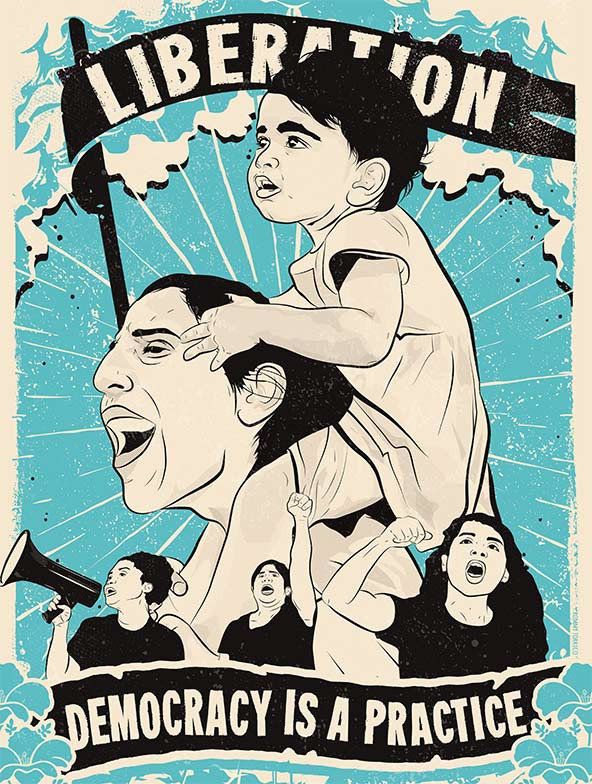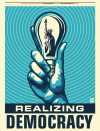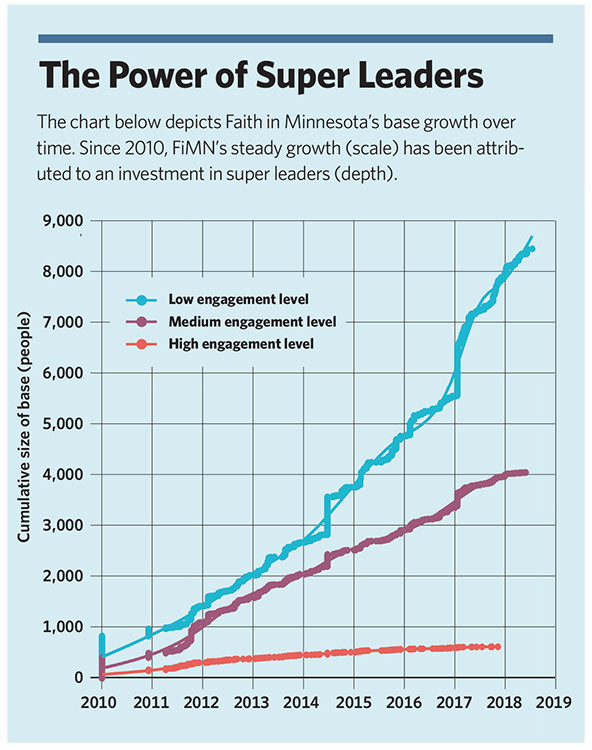 (Art by Rommy Torrico)
(Art by Rommy Torrico)
The continued decline of Americans’ active participation in many aspects of public life is perceived to be common knowledge. Voting rates are one measure of citizen engagement, but there are many others, including campaign donations, volunteer hours, protest participation, online activism, and the density of community groups in a given location. Curiously, many of these numbers have gone up even as the overall health of our democracy—the policies and institutions at work for the people—has decayed.
Realizing Democracy

These articles, funded by the Ford Foundation as part of the Realizing Democracy project, speak to an increasingly shared understanding among policymakers, civil society leaders, and scholars that democracy reform today must address underlying systemic roots of exclusion and inequality. The ideas reflect the views of the authors solely.
In this context, many organizations have designed solutions grounded in a belief in the power of mass mobilization in which they equate an increase in civic activity with a stronger democracy. This logic, however, wrongly assumes “scale” and “depth” to be mutually exclusive. “Scale” means the quantitative breadth covered by an activity—numbers of conversations with likely voters, numbers of names on a list, or numbers of “likes” or “engagements” on social media. The assumption is that the greater the scale, the higher the probability of impact—here, the higher probability of electoral victories or policies passed—in the political or policy arena.
Furthermore, to achieve scaled programs that can produce these prized numbers, paid civic engagement programs are incentivized to prioritize efficiency in order to maximize the number of transactions over depth of relationships—either with an individual or with a community.
The underlying assumption that scale is synonymous with impact should be interrogated—these mobilization outfits produce scale absent of impact, participation without commitment, and breadth without the depth needed to sustain it. Given these challenges and the reality of a political system unresponsive to the demands of the larger public, programs of action should combine scale with impact.
Faith Delegate Story
In 2018, the community-based organizing organization Faith in Minnesota (FiMN) eschewed the standard, scaled political programs and instead devised a two-year campaign and strategy around the Democratic-Farmer-Labor (DFL) state endorsing convention for governor. FiMN first elected and then organized a bloc of 207 delegates and alternates, comprising 11 percent of the total number of delegates and the largest bloc at the convention. These “faith delegates” came into the party process more committed to one another, their organization, and to their shared agenda than to any particular candidate or to the party. The delegates remained uncommitted until they voted as a bloc and agreed to only support the candidate that the collective had agreed to together.
FiMN wanted more than politicians’ attention. The organization’s strategy had four intentions: to define the public agenda for the 2018 governor’s race; to ensure that the campaign narrative of the DFL candidate for governor directly addressed Islamophobia, racism, and white nationalism; to prepare the ground for an election that would build a mandate for a “bold governing agenda”; and to ensure that the constituency of FiMN would be in a co-governing relationship with the new governor’s administration. With more than 200 organized delegates with voting power at the convention, FiMN had enough disciplined people power to determine the outcome of the endorsing convention—and, more broadly, to shape the agenda and narrative of the candidates for governor in 2018.
In the past, many large organizations, such as labor unions and interest groups, similarly sought to affect the outcome of the DFL state endorsing convention. Yet when it came time to endorse, they had always failed to hold their bloc together. Several candidate’s campaigns and their allies attempted to “split the bloc” of FiMN by appealing to individual delegates, whose personal preferences for each of the three major candidates did indeed vary. Although historical precedent suggested there was no way the bloc would hold, the FiMN delegation was successful.
How did FiMN arrive at this moment of collective discipline? They first invited 500 members of its base to be core organizers of the path to the state convention. Those volunteers were invited to organize others to attend precinct caucuses, to build their own individual “campaign” to become a state delegate, and to remain uncommitted to any campaign or candidate until it was clear how FiMN would act as a collective. These volunteer leaders organized close to 2,000 people to attend house meetings six months in advance of the state convention. Then, FiMN’s 500 volunteer organizers trained and transported 3,500 people to attend precinct caucuses, equipped 1,500 FiMN supporters to attend Senate District conventions, and ultimately made it possible for FiMN to secure 11 percent of the total DFL endorsing convention.
The secret of the success of this program was the investment in the 500 volunteer organizers. Most of these grassroots volunteers had never been to precinct caucuses and certainly had never attended a party endorsing convention. These 500 leaders are connected to community-based, member institutions of FiMN such as childcare centers, barbershops, congregations, and mosques. Of the total delegation to the state convention, close to half were people of color, a third were from rural and small towns, a quarter were Muslim, more than two-thirds had never before participated in a party process, and many had never even voted in an election. In other words, communities of people who are constantly politically redlined out of the democratic process were part of the most influential voting bloc at the Minnesota DFL (Democratic) nominating convention.
Takeaways for Collective Power
While FiMN was leading this strategy, a team of researchers prospectively tracked the campaign to document, analyze, and learn from how the organization built and wielded people power. Three takeaways crystalized from the interviews, participant and direct observation, and 10 years of leadership and membership data accumulated by FiMN.

Sustained “super” leadership | Prior to the campaign, FiMN’s 500 faith delegates had participated in a median of five activities. Many of the delegates were thus a part of FiMN’s preexisting base of highly engaged volunteer leaders, while others were brought in through the campaign. Since 2010, the base has grown to now include more than 13,000 Minnesotans.
FiMN spends most of the organization’s time and energy on leadership development, rather than on episodic mobilizations built around urgent calls (or clicks) to action. What this means in practice is that a significant amount of organizational resources are invested in developing “super leaders” (reflected in the steadily growing high-engagement line in Figure 1). They are the reason FiMN—a relatively small community organization with a team of 12 paid organizers—was able to reach tens of thousands of caucus-goers and voters in 2018. Although smaller in number than FiMN’s lower-engagement membership, which tend to show the steepest increase in participation around election cycles, the super leaders are the core of the organization.
Wielding people power: a combination of organizing and mobilizing | The researchers found that it was not only the number of events that FiMN members participated in that was associated with the organization’s leadership capacities and political power, but also the quality and sequence of their participation. Contrary to the conventional wisdom, which conceives of most civic-engagement work as voter-facing mobilization work, the findings show that the majority of FiMN’s faith delegates become committed—to each other and to the collective—in the organizational context of meetings, trainings, and strategy sessions. At these trainings and meetings, leaders of different races, religions, and social classes related to one another, practiced democratic and public skills, discovered their own capacity to lead, and learned how to engage other people in shared strategic action. FiMN was able to draw on the civic and relational capital it had built over the years to deploy when it counted.
A multiracial, multiregional, and multifaith base | The mass mobilization approach would prescribe a strategy whereby FiMN built its programs around “high-propensity voters”—a euphemism often used to refer to middle-class white voters living in places like Minnesota’s Twin Cities. After conducting a power analysis, however, FiMN chose to instead build a state-wide base of leadership that was multiracial, multiregional, multifaith, with multiple centers of power that could be networked into shared strategy and called to take collective action, as happened during the 2018 election.
It took five years to build multiple centers of leadership within key regional centers. FiMN now has a presence in small towns, mosques, barbershops, and congregations across the state. The organization now has chapters and teams of leadership growing in the small towns and regional centers that represent a critical constituency for governing power in Minnesota. Leadership advocating for racial and economic justice in rural and small-town regions makes the difference in whether or not a policy even gets a hearing at the state capitol. FiMN’s faith delegate campaign sheds light on how civic organizations can build power by investing in a well-trained base of people who are committed to one another.
But questions remain: What, for example, are the tradeoffs of funneling large amounts of money to civic organizations during election years, while starving them of the funds required to do sustained, relational, multiyear organizing on off-years? And what are the organizational conditions—the structures, routines, decision making, and data practices—that enable members to both have a voice in overall strategy and still act as a disciplined collective? How do we distribute not just capacity but strategic capacity?
Although it is more challenging to document or “measure” depth than scale, FiMN’s faith delegate campaign transformed the level of influence of the organization in the public arena. This new power is shared by the whole base and has caused both an expansion in the capacity to influence policy and systems, but also an expansion in membership and engagement. Those who are volunteer leaders in FiMN have a visceral experience of politics working for them—not just working for a candidate or a particular issue or a cause. This creates a virtuous cycle where more people become involved because those who have had a direct experience of public power invite others to join in the journey.
This article appeared in the Winter 2020 issue of the magazine with the headline: “People Power”
Support SSIR’s coverage of cross-sector solutions to global challenges.
Help us further the reach of innovative ideas. Donate today.
Read more stories by Doran Schrantz, Michelle Oyakawa & Liz McKenna.

